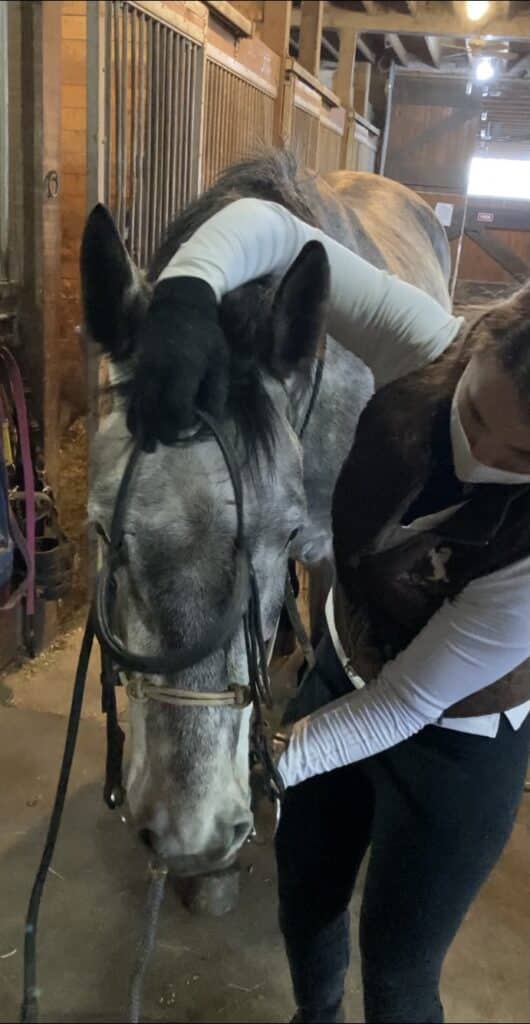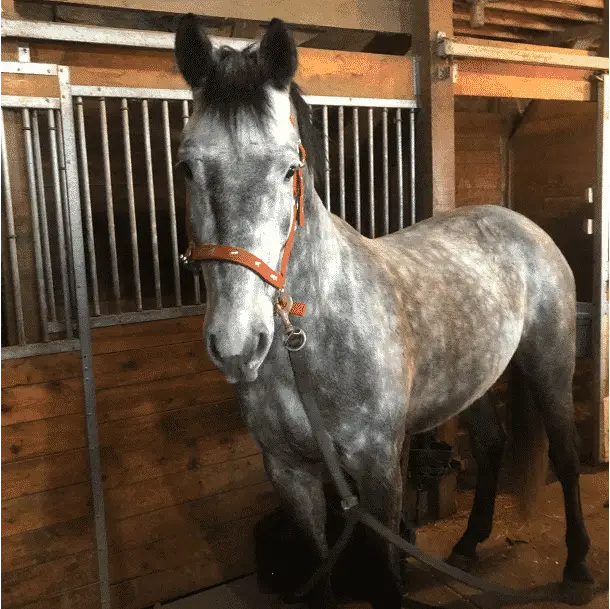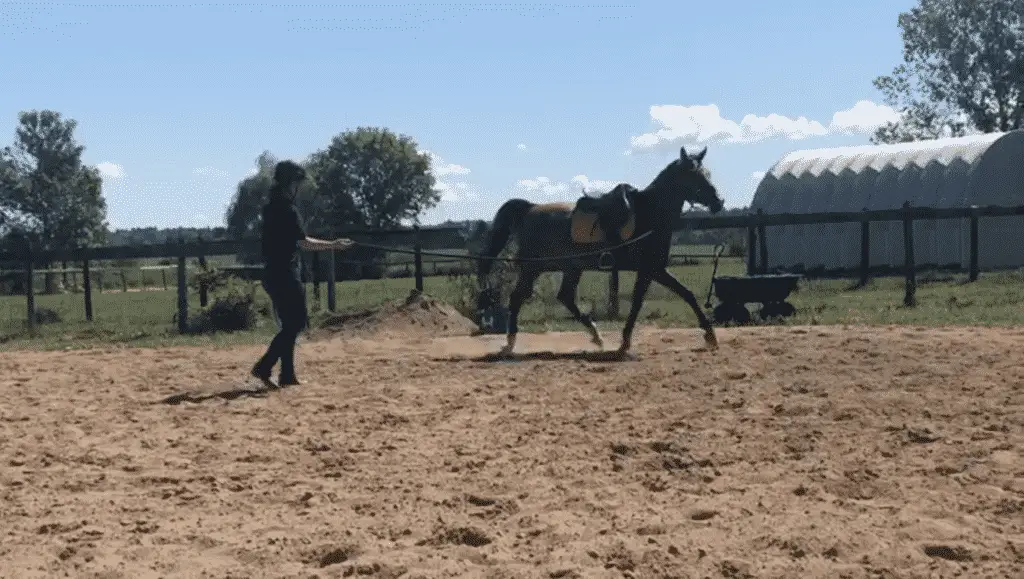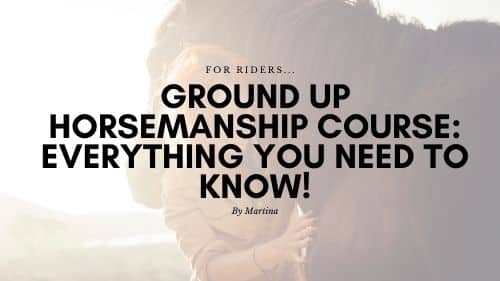You Know How to Ride. Now, It’s Time To Learn How to REALLY Communicate With Your Horse…
Let Me Show You How To “Talk” To Your Horse!
Level Up Your Riding by Learning How to Communicate with Your Horse

I’m being serious.
Anyone can talk to horses. Not just “horse whisperers”.
You just have to learn how.
And when you do learn how, you can stop relying on those quick tricks to get your horse to do what you want.
Once I learned how to talk to my horse, my riding became effortless.
Ground Up Horsemanship will teach you exactly how to get there.
Here’s the Thing
There’s a lot of different quick tricks to get horses to do what you want them to do. “Emergency breaks”, spurs and harsh bits get results, but they will only get you so far.

The Ground Up Horsemanship Framework
1. Understand Your Horse
Learning horse psychology and behavior is the first step to effectively communicating with your horse.
This peek into your horse’s psyche will help you understand why your horse doesn’t always follow your commands.
2. Build a System of Communication
Next you’ll develop a framework for communicating with your horse.
You’ll understand how to put yourself in your horse’s “shoes” so to speak in order to solve any problem that comes up rather than just apply a copy-paste solution.
3. Apply It to Your Tasks
Once that system is built, it becomes the foundation to accomplish tasks you want from your horse.
Whether that’s basic manners (i.e. standing still, not biting) or more complicated tasks (i.e. lateral work, water jumps), communication is the key.
The only thing stopping you from taking your riding to the next level is clear communication between you and your horse.

There are some amazing tactics out there that can achieve results for specific problems that come up frequently with your horse.
You’ve heard them all before.
Hacks on how to move a slow horse forward, how to slow a hot horse down, how to make a horse stand still, how to get a horse to stop biting, and on and on.
They work, but I don’t like relying strictly on hacks and I don’t want you to either.
I want you to understand why the horse is doing what they’re doing and develop a sort of “language” so that you can tell the horse what you want to do next.
I want you to understand the fundamentals of horse behavior so that you know how to address any problem rather than having to remember tactics for each specific issue.

Ground-Up Horsemanship is unique because it doesn’t include any “human” biases in the system. We’re not trying to achieve any specific goal with the horse. We’re not trying to create a barrel racer or a show jumper or a race horse or even a liberty horse.
Ground-Up Horsemanship is based on understanding the horse and then using that understanding to develop a communication system with the horse.
You will, of course, get the step-by-step tactics on how to do ground work, establish basic manners with your horse during handling and obtain the desired responses while riding. In ADDITION to this, you will get an explanation for every one of these tactics about why they work based on horse psychology and why horses behave in the way they do.
You’ll learn how to trouble-shoot problems from the “ground up”.
Soon, you’ll be the go-to person in your area for all your friends’ horse problems!
5 Weeks To Speaking “Horse”
I
Understanding how horses think.
You will learn why horses behave the way that they do based on their natural herd dynamics.
II
The basics of handling such as leading, standing still, grooming, and fetching from the field.
III
Groundwork to refine your communication with your horse and build trust.
Using groundwork to address the problems that your horse is having or work on issues you know you’re having in the saddle.
IV
Learn specific tactics to solve problems and why they work.
You’ll learn how to give clear, confident commands and how to reinforce them in a way that you know will work.
V
How to troubleshoot using specific case examples.
Learn to approach any problem that you have with your horse, either in or out of the saddle, and come up with a solution.
BONUSES
Bonus # 1: Goal setting as a horseback rider.
Bonus # 2: How to overcome performance anxiety.
My Embarrassing Truth
I had a lot of horseback riding lessons and I got to a very high level of English riding but certain things would always get to me.
Every once in a while, I would have trouble getting the horse I was riding from the field. Or I wouldn’t be able to tack up my horse because he would throw his head while I was trying to get his bridle on. Or I would try to get a horse up to a brisk trot on a hot day and he just wouldn’t want to move forwards.
During all of these scenarios, I would get help from another rider or my coach.
It was so embarrassing!
I would tell myself that it was fine and that this happened to everyone but part of me was always nervous around horses because of that.
I longed for the ease that my coach seemed to have. The ease that seemed to come from having an understanding with the horse and the confidence of just knowing that the horse would listen.
Even after riding for 15 years, I would still struggle with basic handling of my horse at times.
Getting My First Horse
Once I got my own horse, I couldn’t rely on anyone else anymore. It was just me and my horse and if I wanted to ride him, I needed to get him from the field, tack him up and get him listening to me in the arena or on the trail.
This is the point that I realized I needed to learn how to really understand him and how to communicate with him in an effective way.
I got a lunge line and started working with him on the ground. I started watching him and trying to understand his behavior and his responses to my body language.
Slowly, I started to realize what worked, what didn’t and why because he would show me immediately if what I was doing was making sense to him. I started to understand the concepts of pressure and release.
Communicating in that direct, clear way with a horse is something that I never thought I would be able to do. But it’s actually not that hard! Really, anyone can do it if they know the steps.

After I got my first horse, I had no choice but to learn how to properly communicate with him. No one was there to bail me out. The transformation to my confidence and my riding was like night and day.
Why Ground-Up Horsemanship?
I get really excited when I talk about Ground-Up Horsemanship. It’s a unique system-based approach to horse problems.
I love sharing it because it gives you the tools that you need to handle anything your horse throws at you rather than just giving you a copy-paste approach to one problem.
Horses are living, breathing and extremely intelligent animals; they will sometimes outsmart the copy-paste solutions!
Not only will you get the huge benefit of always knowing what to do in sticky situations thereby avoiding embarrassment, but there is absolutely nothing like having that bond with your horse where you just know that they’ll respond to whatever you ask. Of having that calm confidence of just being in sync with your horse and never having to second guess what you’re doing or why you’re doing it.
If you have a horse that’s exceptionally well trained, you can certainly ride at an exceptionally high level without ever really understanding horses or how to really communicate with them.
I’ve been there!
But it’s just not the same because you’ll never have that confidence if the horse were to question you in any way. You just wouldn’t have an answer for him and then everything falls apart (unless your coach is there to rescue you).
If you have your own horse, then you already know that you need to be able to do this stuff. I definitely don’t need to tell you!
If you are riding school horses or have some sort of lease arrangement, however, this is so important for you as well! I went years without really knowing what I was missing but I knew there was definitely something.
Learning this stuff will take your riding to the next level and will finally get rid of all of those little anxieties when your horse just doesn’t listen and you don’t know why.

Don’t Be Stubborn Like Me!
I didn’t grow up on a ranch but I grew up riding whenever my parents would take me and, of course, I was the crazy horse-girl to all of my friends.
I would get as many lessons as I could afford mostly focusing on Dressage and Hunter/Jumper. I had a natural knack for it and I was a quick learner so very soon was at an advanced level.
Over the course of almost 20 years, I rode a lot of different horses at a lot of different stables. When the horse was on board, my riding was excellent but all these little issues would pop up if the horse was slower, hyper or more stubborn that day and especially when no one else was around.
For example, at times the horse wouldn’t let me get him from the paddock, I couldn’t pick up his hooves while grooming him, I couldn’t get him to go forwards at the beginning of a lesson by myself, he would refuse the first few jumps because he wouldn’t get up the necessary speed, the canter transition wasn’t as smooth as it should be.
I brushed all these things off because it wasn’t my horse and someone was always around to help me.
It wasn’t until I could afford my own horse that I suddenly had no choice but to fix all those little problems that inevitably pop up myself.

“Horses are never wrong. They always do what they do for a reason, it’s up to you to figure it out.”
– Jeanette Walls
Riding Is Not The Same As Horsemanship
One day, I picked up a lunge line and just took my horse out to the arena on his halter. My horse was immediately completely focused on me and my signals.

After a few hours, I started to realize what body language worked, what didn’t and why because he would show me immediately if what I was doing was making sense to him.
Looking back on those days now, I realize that although I may have been a good rider for a long time in the setting of a lesson, I was not a good horse person and because of that I was not a great rider.
I had good balance, strength, knowledge of classical cues but I didn’t understand my horse.
I was missing the back and forth communication. I was missing the confidence and ease that comes with knowing you can back up and enforce all of your commands with your horse.
It’s the best feeling knowing that I don’t ever need to rely on someone else to fix my horse problems.
I’m no longer the embarrassed person running around in the field trying to catch her horse or the person struggling to get the bridle on for 20 minutes while her horse throws his head.
I also have the confidence to take my horse out on my own for long trail rides near roads, over streams, in the woods knowing that I’ll be able to handle anything that happens and I want the same for you!
Does it cost anything?
Nope! As of right now, this guide is completely free. (It might not always be that way, though!)


My husband bought me a horse for my 46th birthday. I’ve ridden horses with my friends, but never owned my own horses.. My mare is going to be 4 in April, and we have been working on groundwork, and last year, we had 2 successful rides in the round corral. We have great communication, but I’m still learning, and of course so is she! I want to get more confident!